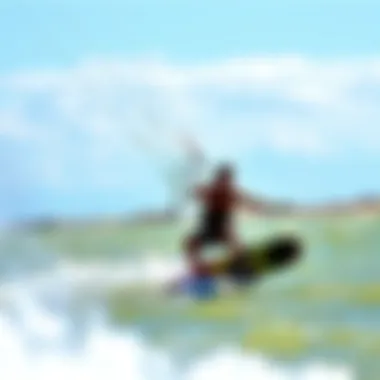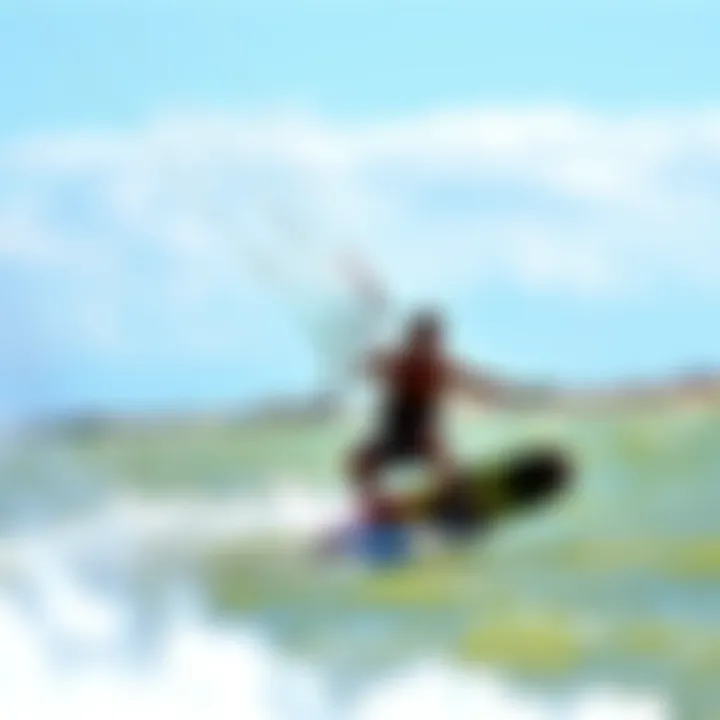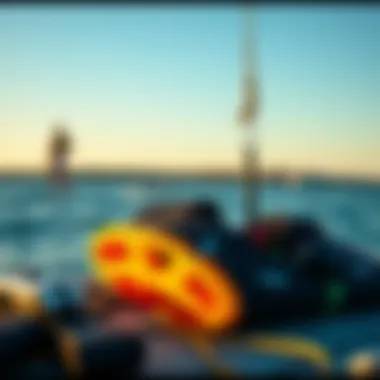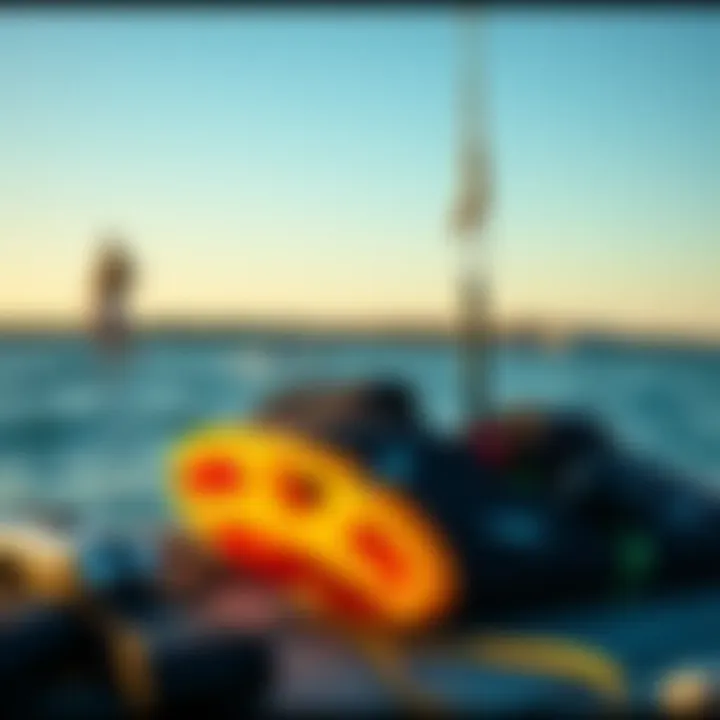Mastering the Dallas Wind for Kiteboarding Success


Intro
In the vibrant expanse of Dallas, where urban sprawl meets open skies, wind patterns tell a story all their own. For kiteboarding enthusiasts, this narrative is vital, shaping every session on the water. Understanding how the local wind behaves can spell the difference between a frustrating outing and a day filled with exhilarating rides.
Kiteboarding isn’t just about the kite or the board; it’s about how you engage with the elements around you. The Dallas wind can be capricious, influenced by the city's topography and varying weather conditions. By grasping the intricacies of these winds—from the gusty north winds during cooler months to the soft breezes of summer—kitesurfers can optimize their experiences.
This guide will delve into gear selection, essential techniques for mastering kiteboarding, and how to navigate the unique wind patterns found in Dallas. Whether you're a seasoned rider or a curious novice, this exploration will prepare you to harness the winds to your advantage.
The Nature of Wind in Dallas
Understanding the wind in Dallas is essential for anyone looking to enhance their kiteboarding experience. The wind here is not just any old breeze; it carries its own set of characteristics and behaviors that kiteboarders must grasp to effectively navigate the waters. The unique aspects of the Dallas wind can either be a friend or a foe, depending on how well one understands its nuances.
When kiteboarding, recognizing patterns in the wind will allow enthusiasts to choose the right time to hit the water. The role of meteorological factors cannot be overstated, as they deeply influence wind patterns. Furthermore, recognizing the seasonal shifts helps in comprehending how the wind interacts with one’s environment. This guidance leads to safer and more enjoyable experiences on the kite.
Meteorological Overview
The meteorological overview of Dallas wind is pivotal for kiteboarders. Here, the Texas climate combines with the geographical layout to create a diverse wind landscape. The presence of factors like temperature variations, local terrain, and seasonal weather systems all contribute to the wind patterns observed in the region.
Dallas experiences a generally humid subtropical climate, which means that wind patterns can change quite rapidly. One moment, kiteboarders might find themselves embracing gentle breezes, while a sudden shift in air pressure can bring chaotic gusts. A keen understanding of these meteorological elements will keep kiteboarders both informed and agile.
Seasonal Variations
Wind conditions are not static; they ebb and flow with the seasons. From the vibrant winds of spring to the biting gusts of winter, every season plays an integral role in shaping the kiteboarding experience. Each seasonal variation offers a unique flavor to the wind, impacting both the technique required and the equipment suited for the task.
Spring Wind Patterns
Spring begins to shake off the chill of winter, often bringing in erratic and invigorating winds. During this time, kiteboarders can expect wind patterns that shift not just daily but hourly. The blossoming of flora contributes to a certain vibrancy in the air that new kiteboarders may find exhilarating. What makes spring particularly enticing is the average wind speed; it's usually less harsh compared to those found in summer which makes it a favorable time for those learning the ropes.
However, spring winds can play tricks on novices, as they can gust unexpectedly, necessitating a level of caution alongside excitement.
Summer Heat and Wind
As summer rolls around, the heat can become nearly palpable. Interestingly, while high temperatures might imply stagnant air in some regions, Dallas positions itself in a unique niche. The warm air can cause updrafts, leading to beautiful yet incredibly tricky wind patterns. Kiteboarders might find this a double-edged sword; the conditions can be great for advanced riders looking to catch high-speed thrills, yet beginners might feel overpowered by the sudden bursts of energy. Elevated temperatures and the associated wind conditions can create a real adventure in the air, but they can just as quickly turn into a test of skill and perseverance.
Autumn Changes
As the trees begin their shift towards fiery autumn colors, the wind in Dallas enters a transitional phase. The once fierce summer gales often mellow out, offering smoother rides. Autumn tends to have a stabilizing effect on wind patterns, providing a consistent breeze that many kiteboarders find appealing. The moderate temperatures combined with these winds create a comfortable environment for long sessions at the water.
One must, however, remain vigilant as cold fronts can sweep in unexpectedly, potentially altering the wind's temperament at a moment's notice.
Winter Conditions
Winter brings a stark contrast to Dallas. The wind can become biting and brisk, presenting a whole new set of challenges for kiteboarders. While many might assume that kiteboarding is best timed during warmer months, winter winds can surprise those willing to brave the chill. The air is often clean and crisp, leading to good visibility but also requiring thorough preparation. Kiteboarders must gear up accordingly, with wind-resistant attire and equipment that performs well in frigid temperatures.
Wind Speeds and Their Impact
The importance of understanding wind speeds cannot be overstated for kiteboarding enthusiasts in Dallas. Wind speed directly influences not just the performance of the kiter but also the safety and enjoyment of their experience on the water. A gusty day can turn a fun ride into a challenging session, while consistent breezes can support a thriving kiteboarding environment. As any seasoned rider knows, wind can indeed be both friend and foe.
By becoming acquainted with the nuances of wind speed, kiteboarders can better strategize their outcomes, ensuring they choose the right time and conditions to hit the water. This section will deep-dive into how wind speed measurements inform kiteboarders on their choices and performance.
Understanding Wind Speed Measurements
Wind speed is typically measured in knots, miles per hour, or meters per second. For kiteboarding, understanding these measurements aids in determining feasibility and readiness to ride. The nuances in these numbers become critical when planning a day on the water.
- Knot (kn): Commonly used in maritime contexts, one knot equates to just over 1.15 miles per hour. It offers a clear-cut communication method among water sports enthusiasts.
- Miles per hour (mph): A standard measurement in the United States, wind speed in mph is comfortable for most kiteboarders navigating local options.
- Meters per second (m/s): This is more frequently used in scientific contexts but may provide a clearer understanding of speed relative to broader meteorological phenomena.
Arming oneself with a solid understanding of wind measurements cultivates an informed kiteboarding experience and should not be overlooked. Riding in the right wind speed can mean the difference between smooth sailing and precarious conditions.


Wind Speed Ranges for Kiteboarding
When it comes to kiteboarding, certain wind speeds are more favorable than others. Having the knowledge of wind speed ranges can help different skill levels navigate the sport more effectively.
Optimal Speeds for Beginners
For those just starting out, playing it safe is key. Optimal wind speeds for beginners range from 10 to 15 knots. At this range, the wind is brisk enough to allow for initial liftoffs and basic maneuvers without the overwhelming power that stronger winds can bring. The opportunity to practice control while riding isn’t only beneficial; it builds a solid foundation for future kiteboarding skills.
Riding in these conditions can foster confidence and prevent mishaps that often stem from overpowering winds.
Ideal Conditions for Advanced Riders
For advanced riders, the circumstances shift dramatically. These kiteboarders typically favor wind speeds peaking between 15 to 25 knots. The extra push from higher wind speeds brings a heightened thrill and the potential for more complex tricks. The sense of control devotees feel in these conditions allows them to harness that wind energy proficiently.
"Advanced kiteboarders thrive on the challenge—strong winds invite innovative tricks and exhilarating rides!"
Each wind condition, whether perfect for a beginner or advanced kiteboarder, carries its own characteristics. Kiteboarding becomes not just about the ride, but about understanding personal limits while embracing the wind's power.
Closure
Understanding wind speeds is paramount to nurturing a successful kiteboarding experience in Dallas. By equipping themselves with this knowledge, kiteboarders enhance their ability to gauge when to harness that thrilling wind, making the sport safer and more enjoyable.
Geographic Influences on Wind Patterns
Understanding wind patterns in Dallas involves more than just meteorological data; one must consider the geographic factors that create and modify these breezes. The unique combination of natural features and human-made structures around Dallas plays a significant role in shaping wind behavior, which is essential knowledge for kiteboarding enthusiasts.
Topography of Dallas
The topography of Dallas is not entirely flat, desert-like fields, as some may imagine. Rather, it consists of a variety of features, including rolling hills and the meandering paths of the Trinity River. These geographical elements influence how wind flows through the area. For example, the higher elevations on the outskirts can act as conduits for wind, channeling it towards lower areas where kiteboarders often set up their gear.
In addition, open spaces, such as parks and fields, create regions of low resistance, allowing the wind to pick up speed. If you're kiteboarding near White Rock Lake, you may notice that the wind feels stronger due to the open expanse of water reflecting gusts upward. On the flip side, areas with dense trees or tall buildings can obstruct wind flow, which can lead to unexpected shifts in direction or speed. This transformation creates what some kiteboarders refer to as "wind pockets," spots where the conditions can suddenly feel wildly different.
Effects of Urban Development
As Dallas has grown, the urban landscape has influenced local wind patterns significantly. Tall buildings and layouts of roads can disrupt natural wind flows, causing the air to swirl in unpredictable ways. This phenomenon, known as urban wind shear, can create turbulence that might be daunting for even the seasoned kiteboarders.
When venturing near downtown, you might find that the wind changes dramatically depending on which street you’re on or how far you’re away from the skyscrapers. For example, if you’re riding near the George W. Bush Turnpike, expect a mix of gusts that can hit you from various angles, making it challenging to maintain control.
However, not all urban effects are negative. Open areas amongst the concrete, like parks and recreational spots, can harness wind currents effectively. Although the buildings might cause inconsistent conditions, they can also create avenues of steady airflow in specific locations—this duality means that, as a kiteboarder, you can simplify your strategy by familiarizing yourself with these spots.
"Getting to know your surroundings is half the battle in kiteboarding—understanding how wind interacts with the landscape will be your ace in the hole."
When you consider wind patterns in Dallas, it's clear the geographic elements create a complex tapestry of influences. Familiarizing yourself with the local topography and urban environment not only enhances your kiteboarding experience but also ensures greater safety and enjoyment out on the water.
Kiteboarding in Varying Wind Conditions
Kiteboarding enthusiasts know that the wind can be both a friend and a foe. Understanding how to manage varying wind conditions is central to enjoying this thrilling sport safely and effectively. Kiteboarding in Dallas presents unique opportunities and challenges due to its dynamic wind patterns. Mastering these conditions not only enhances the thrill of each ride but also sharpens one's skills. Whether you're just starting out or have been riding the waves for years, knowing how to adapt your approach to different wind scenarios can make a world of difference in your kiteboarding experience.
Adapting to Strong Winds
Strong winds can make or break a kiteboarding session. While some might shy away from these gusts, savvy kiteboarders see them as an opportunity to elevate their skills and push their limits. Learning to adapt is crucial, especially when conditions shift unexpectedly.
Gear Selection
Choosing the right gear can mean the difference between an exhilarating session and a dangerous one. For strong winds, you’ll want equipment that is both durable and responsive. Many experienced riders opt for smaller kites. The logic behind this is simple: smaller kites respond quicker and are easier to control in gusty conditions. A well-chosen kite might range from 7 m² to 10 m² depending on the wind speed.
A sturdy board, ideally with a stiffer flex, helps riders maintain control and absorb the choppy water. It is vital to check that your harness and lines are in top shape, too. Equipment that can endure the intensity of strong winds is critical for both safety and performance.
Technique Adjustments


A shift in wind strength requires adjustments in technique. Riders must prioritize maintaining balance while harnessing the power of the wind. Low position techniques, such as bending knees and keeping the kite low, are often recommended in these gusty situations. This posture reduces the risk of being lifted unexpectedly and helps maintain control. In essence, using your body effectively aligns with the kite's movements, leading to better response to sudden changes.
You might also find that mastering the art of edging becomes vital. Keeping your board tilted against the wind allows for firmer traction and stability. Remember, while strong winds can serve up thrilling challenges, they also demand heightened awareness and precision.
Navigating Light Winds
Light winds can be frustrating for kiteboarders hoping for an exhilarating ride, but these conditions offer their own rewards. With the right approach, light winds can lead to a remarkable experience that enhances your skills and creativity.
Choosing the Right Equipment
When it comes to light winds, equipping yourself with the right gear is paramount. Larger kites, typically in the 12 m² to 17 m² range, help you catch more air from the weaker breeze. These kites glide gently and are easier to keep afloat in lower wind speeds. Additionally, a light wind board typically has more surface area and a flatter shape, providing extra lift and allowing for easy planing.
The downside? Larger kites can become cumbersome in stronger settings, demanding quick adjustments. Thus, keeping a range of equipment handy might be beneficial for those unpredictable Dallas breezes.
Performance Tips
When faced with lighter breezes, one needs to prioritize technique and approach. Staying low and balanced, while urging the kite in an upward motion, can help catch those elusive gusts. Patience plays a huge role; the wind might strengthen at the most unexpected time, so be ready to react.
Another tip is to focus on smooth, fluid movements rather than abrupt, jerky motions, which can disrupt momentum. Engaging the core is also essential, as a stable center of gravity helps maintain balance. In summary, light winds challenge kiteboarders to be strategic, teaching them how to extract the maximum fun from minimal conditions.
Kiteboarding isn’t just about rides; it’s about mastering nature's temperament to create unforgettable experiences.
By adapting gear and techniques according to the wind conditions, kiteboarders in Dallas can unlock a world of thrill that is often overlooked. Whether the wind is howling or whispering, there's always an opportunity to ride the waves.
Safety Considerations Related to Wind
Kiteboarding is an exhilarating sport that offers a blend of thrill and challenge. But with that excitement comes an inherent responsibility to prioritize safety, especially when navigating the often unpredictable winds of Dallas. Understanding wind conditions and the potential hazards involved paves the way for a safer and more enjoyable experience on the water. This section highlights the essential elements of safety related to wind while kiteboarding, emphasizing the benefits of preparedness and awareness.
Understanding Wind Gusts
Wind gusts are sudden increases in wind speed, and they can turn a seemingly perfect kiteboarding day into a precarious situation. These unpredictable bursts of wind can catch even the most experienced kiteboarders off guard. Being aware of wind gusts is crucial; they can lead to loss of control, resulting in falls or collisions with other riders or obstacles.
Here are some points to consider regarding wind gusts:
- Recognizing Patterns: Wind gusts often occur in squalls or near terrain changes. Keeping an eye on cloud formations and nearby trees can provide clues about the wind's behavior.
- Equipment Setup: Ensure your gear is suitable for gusty conditions. A smaller kite may be more manageable during gusty winds, providing better control.
- Adjusting Riding Techniques: Beginners may want to practice in lighter, more stable winds before tackling gusty days. Maintain a steady stance and be ready to depower your kite quickly if a gust picks up unexpectedly.
"Gusts are like unexpected curves in the road; it's how you handle them that determines your journey."
Emergency Protocols
No matter how prepared you might feel, emergencies can happen, especially in kiteboarding where the wind plays a major role. Having a well-planned emergency protocol can mean the difference between a close call and a serious incident.
A few key points on establishing effective protocols include:
- Gear Familiarity: Understand how to operate your gear under stress. Make time to practice self-rescue techniques and know how to fully depower your kite in an emergency.
- Buddy System: Kiteboarding is much safer when you have a partner on the water. Communicate your plans to each other, and ensure your friend knows how to assist you if something goes awry.
- Incident Reporting: Be ready to document any accidents or close calls. This helps understand recurring issues in specific areas and can aid in improving safety for everyone.
- Stay Educated: Attending kiteboarding safety workshops can be invaluable. Local kiteboarding clubs or schools often provide these resources, allowing you to learn from experienced instructors and fellow riders.
- Emergency Contacts: Keep a list of local emergency numbers handy. Programs like SOS on smartphones can also help alert medical services if needed.
By implementing these considerations and protocols, kiteboarders can enjoy Dallas's winds without putting themselves or others at risk. The sport remains an adventurous and safe activity when approached with caution and preparation. Prioritize safety, and let the winds of Dallas guide you to new heights.
Environmental Considerations of Wind Patterns
Understanding the environmental considerations of wind patterns in Dallas is essential for kiteboarders who wish to enjoy their sport while being mindful of local ecosystems. The wind not only affects the conditions of kiteboarding; it also plays a critical role in shaping the environment. This section will explore these dynamics, emphasizing the interconnectedness of wind, kiteboarding, and nature.
Impact on Local Ecosystems
The winds in Dallas have significant effects on the surrounding ecosystems. Seasonal shifts in wind patterns influence plant growth and animal behaviors, creating a unique environment that is both a playground for kiteboarding and a home for various species.
- Pollination: Wind transports pollen, affecting plant reproduction and contributing to the area's biodiversity. Ideal wind conditions can lead to flourishing wildflowers in spring, providing splendid scenery for kiteboarders.
- Habitat Disruption: High winds can disrupt habitats, causing the displacement of small creatures. Kiteboarders should be aware of their impact while enjoying the wind in their sails.
- Soil Erosion: Strong gusts can lead to soil erosion, changing landscapes and ultimately affecting the stability of nearby waterways. Recognizing this, kitesurfers should avoid areas that show signs of significant erosion to mitigate further damage.
In understanding these elements, kiteboarders can appreciate the fragile balance of their surroundings and the consequences that can follow their actions.
Promoting Responsible Kiteboarding Practices


As kiteboarders navigate the exciting winds of Dallas, it is crucial to promote responsibility. Sustainable practices not only ensure a safer environment for local wildlife but also enrich the kiteboarding community as a whole.
Leave No Trace Principles
The "Leave No Trace" principles emphasize minimizing human impact on the environment. By following these guidelines, kiteboarders can engage in their sport while preserving the beauty of Dallas's natural landscape.
- Key Characteristic: At its core, this principle encourages outdoor enthusiasts to leave areas as they found them. This includes cleaning up trash, minimizing noise, and sticking to established paths.
- Why It's Beneficial: Such practices reduce the risk of harming local wildlife and prevent pollution, contributing to a healthier ecosystem. It also fosters a culture of respect within the kiteboarding community.
- Unique Feature and Advantages: The unique aspect of the Leave No Trace approach is that it applies to every outdoor activity. Its advantages extend beyond kiteboarding; they influence the broader community's relationship with nature, promoting sustainability and environmental education.
Respect for Wildlife
Respecting wildlife is paramount for kiteboarders who want to ensure the ongoing health of Dallas's ecosystems. Kiteboarders should be aware of seasonal breeding areas or nesting sites to prevent disruption.
- Key Characteristic: Understanding the habitat needs of local species helps kiteboarders make informed decisions on where to practice their sport, steering clear of sensitive areas.
- Why It's Beneficial: Respecting wildlife contributes to local biodiversity, ensuring that unique species remain part of the Dallas landscape. This relationship enhances the overall kiteboarding experience, as wildlife interactions can create unforgettable moments on the water.
- Unique Feature and Advantages: The unique feature of this approach is that it is rooted in ethics. Engaging with nature respectfully not only cultivates a deeper connection to the environment but also sets a positive example for newcomers to the sport.
Through these principles, kiteboarders can enjoy the thrill of the Dallas wind while championing the ecological health of their playing fields.
"Kiteboarding is not just about riding the wind; it’s about preserving the beauty that surrounds us."
With these considerations in mind, kiteboarders of all skill levels can harness the joys of their sport while promoting a greater understanding of and respect for Dallas’s diverse ecosystems.
Forecasting the Dallas Wind
Accurate forecasting of wind in Dallas is crucial for kiteboarding enthusiasts. Understanding how to predict wind patterns not only enhances safety but can also elevate the overall experience on the water. The ability to anticipate weather changes can transform a mediocre kiteboarding session into an exhilarating day on the lake. Wind forecasting helps riders anticipate potential hazards, manage their gear, and align their skills with the conditions they can expect.
Resources for Accurate Weather Predictions
To stay ahead of the wind, kiteboarders need reliable resources. Several platforms offer accurate weather predictions that can inform your next kiteboarding session:
- National Weather Service: This governmental resource provides up-to-date data about wind speeds and weather conditions specific to Dallas. It’s a trusted source for forecasts and warnings.
- Windy.com: This site offers detailed wind maps and graphs, allowing kiteboarders to visualize wind patterns live. The interface is user-friendly, making it easy to interpret data, even for beginners.
- Kiteboarding Forums and Communities: Engaging with fellow enthusiasts can provide localized insights that larger forecasting services might overlook. Check platforms like Reddit or Facebook groups for discussions on recent wind conditions.
Using Technology in Wind Forecasting
Technology plays a significant role in modern wind forecasting. Kiteboarders can tap into various tools that aid in precise weather predictions:
- Smartphone Apps: Many kiteboarding-specific apps are designed to provide real-time wind data. Apps like WindAlert or iKitesurf can give notifications about changes in conditions, ensuring you’re always prepared.
- Doppler Radar: Some advanced services leverage Doppler radar to provide minute-by-minute updates on wind velocity and direction, helping you make informed decisions right before you head out.
- Online Wind Trackers: Websites like PredictWind or SailFlow use crowdsourced wind data, allowing you to see conditions reported by other riders in real-time. The community input can enhance accuracy, as local knowledge often fills in gaps that automated systems miss.
A well-informed kiteboarder can navigate the winds much like a seasoned sailor—understanding not just the power of the gusts but also how to dance with them.
In summary, investing time in learning about wind forecasting resources and technologies can lead to safer and more enjoyable kiteboarding experiences. It’s not just about knowing when to go; it’s about harnessing the elements to elevate your sport.
End: Mastering the Dallas Wind for Kiteboarding
Understanding the wind dynamics in Dallas is crucial for kiteboarding enthusiasts who are serious about improving their skills and maximizing their enjoyment on the water. Knowledge of local wind patterns and conditions allows kiteboarders to make informed choices regarding when and where to kite, enhancing their safety and overall performance. The unique temperament of the Dallas wind—sometimes fierce, at other times gentle—demands that kiteboarders learn to navigate its intricacies effectively.
When kiteboarders master the local wind, they’re not just riding the breeze; they’re harnessing it to propel themselves forward. The benefits of understanding this crucial element are manifold. For one, it empowers riders to choose the right gear for varying conditions. Think of it as a toolbox where each tool has its purpose; selecting the wrong one can lead to less optimal experiences or even accidents. Additionally, recognizing how geographical features affect wind flow aids in locating the best spots for launching and landing.
Moreover, awareness of safety protocols and emergency plans rooted in wind behavior shouldn't be overlooked. Every kiteboarder needs to be prepared for sudden gusts or changes in wind direction. Making it a habit to check wind forecasts before heading out can prevent unfortunate situations; what might seem like a perfect day could quickly turn hazardous. For enthusiasts seeking to improve, regular practice in variable conditions—like those found in Dallas—can build the resilience and adaptability needed for mastering the sport.
The wind is not just a backdrop; it’s a participant in the kiteboarding ballet.
Final Thoughts on Wind Mastery
Mastering the nuances of the Dallas wind is akin to mastering one’s own skill set. Each session on the water teaches something new, whether it’s understanding how the wind behaves in different neighborhoods or testing the limits of one's gear. For beginners, this journey may feel daunting, but it becomes infinitely rewarding as knowledge grows. Experienced kiteboarders can further refine their techniques by interpreting the wind's language, allowing for stunning aerial maneuvers or smooth gliding runs.
Recognizing that wind conditions can vary widely—not just from season to season but even from hour to hour—is key. Kiteboarders should adapt their approach based on real-time assessments rather than relying solely on past experiences. This pivotal difference can overall enhance their enjoyment of kiteboarding while resulting in a more profound connection with the environment.
The Future of Kiteboarding in Dallas
As kiteboarding evolves, so too does the understanding of wind dynamics within the Dallas area. The sport is likely to attract a broader community, leading to a shared knowledge base that can benefit all levels of riders. Increased participation can foster greater awareness around environmental issues linked to wind patterns and kiteboarding.
Already, local kiteboarding communities are engaging in discussions about sustainable practices. Initiatives focused on preserving natural habitats can lead to enriched local ecosystems, which are essential for favorable wind patterns. When kiteboarders act as stewards of their surroundings, the experience becomes not just about the thrill of riding but about fostering a healthy relationship with nature.
Additionally, advancements in technology, whether through improved forecasting apps or new kite designs optimized for local conditions, will shape how future riders interact with wind. As Dallas continues to grow, the wind will always be an unpredictable variable, but with the right blend of technology and community knowledge, kiteboarders will be equipped to embrace its challenges and revel in its benefits.















